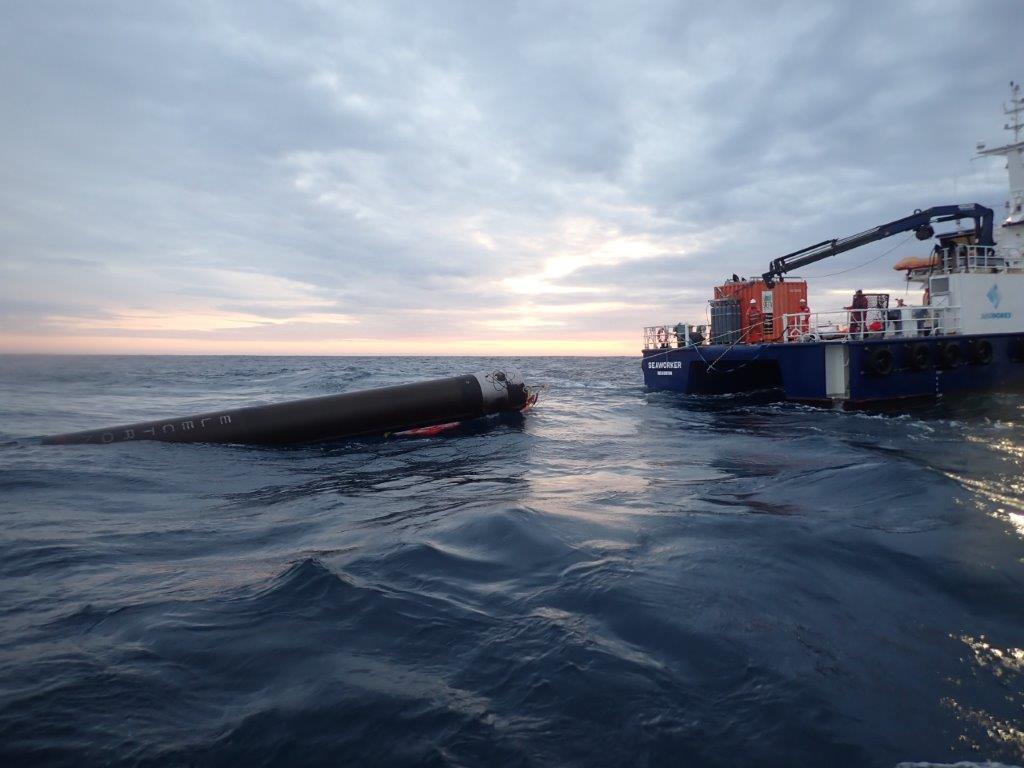
Shortly after Rocket Lab successfully launched its “Return to Sender” mission last week, the company shared today that it had successfully recovered the booster. This is the first time in Rocket Lab’s history that it has recovered a flight proven rocket booster. Rocket Lab joins the ranks of SpaceX in executing booster recovery with intent to re-fly.
After years of doubting Electron’s viability of being able to be reused like SpaceX’s Falcon 9, Rocket Lab CEO Peter Beck announced last year that they would begin tests to see if the first stage could make it back to the Earth’s surface in one piece. 15 months later, Rocket Lab has successfully made an attempt to recover a booster in one piece.
Compared to SpaceX, the leader in re-flyable boosters, Rocket Lab’s plan is a bit unique. Beck mentioned during the announcement of reusable Electrons that there’s no room for landing legs or extra fuel needed to attempt retro propulsive landing. Instead, Rocket Lab’s method tries something SpaceX failed at doing: using parachutes to slow their boosters down. The first couple of attempts by SpaceX to recover their boosters relied on attaching parachutes and having them perform a soft splashdown, but none of those worked.
Rocket Lab is using that same idea, paired with a booster recovery helicopter, to be able to safely retrieve the Electron booster in one piece. During this flight, there was no helicopter to snag the rocket in mid-air like we’ll see in future flights, but the booster did splashdown successfully after perfectly re-entering in the right attitude to not break apart and a ride on a parachute. The booster was recovered via ship during the test.
Update on “Return to Sender”
In a media update on Monday, Beck shared news on their plan for the first recovered booster. NASASpaceflight‘s Chris Gebhardt relayed comments made by Beck during a press call.
The Electron booster made it from space to the ocean just fine, but was beat up by 5 m (16 ft) swells in the ocean. Rocket Lab plans to take the booster back to their factory and tear it apart. Rocket Lab wants to start flying components of flight proven boosters first.
Rocket Lab will try to fly entire boosters once they can start getting clean boosters back from launches. For the early recovery tests, we’ll only see water landings and not helicopter recoveries untill Rocket Lab feels safe adding humans to the equation.
The next Electron booster recovery mission is slated for “early next year”, Beck says. Electron will fly with both expendable and reusable configurations based on mission needs. Beck added that the heat shield performed great despite not being designed for this kind of stress test, and the team will start working on one to better handle the stresses of re-entering the atmosphere next.
Rocket Lab currently builds an Electron rocket about every 30 days. Their goal is to eventually build one per week. Reusability will bring a huge advantage to their output of rockets if the refurbishment doesn’t take more time or money than building a new one.
Rocket Lab gives 1 week update
Rocket Lab released an update this week about how the individual recovery systems performed during the “Return to Sender” mission. Overall, the goals of the mission were successful with the added reaction control systems used to guide the booster through re-entry performing perfectly.
The booster’s drogue shoot deployed 7 minutes and 40 seconds after liftoff and then shortly after the main shoot deployed. Both performed perfectly, according to Rocket Lab. The booster splashed down into the ocean at 9 meters per second (20 mph), slightly slower than the teams expected.
Rocket Lab said that “the stage held up remarkably well” after it re-entered the atmosphere. The heat shield, though not designed for the heat experienced during re-entry, did experience some heat damage. Rocket Lab wanted to learn what would happen if they left it unchanged and will take this data learned and strengthen it for future recovery missions.
We achieved everything we set out to with the Return to Sender mission, and now we’re confident Electron can become a reusable launch vehicle, so it’s onto the next one.
Rocket Lab

Rocket Lab plans to launch another recovery mission next year with a similar profile to validate its data. They also plan to re-qualify and re-fly some components from this booster for future missions.
Enjoy reading Space Explored?
Help others find us by following on Apple News and Google News. Be sure to check us out on YouTube, Twitter, Facebook, and Instagram, join our Discord!
FTC: We use income earning auto affiliate links. More.




Comments